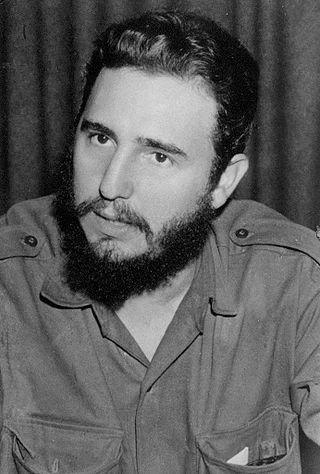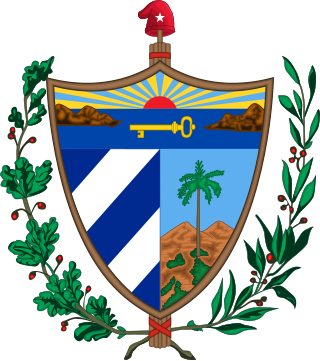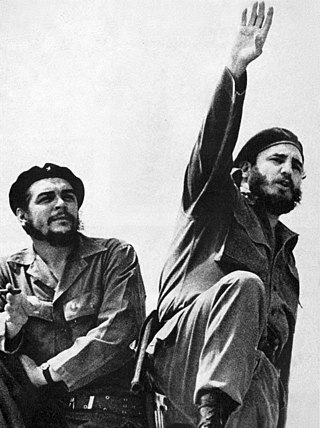The island of Cuba was inhabited by various Amerindian cultures prior to the arrival of the explorer Christopher Columbus in 1492. After his arrival, Spain conquered Cuba and appointed Spanish governors to rule in Havana. The administrators in Cuba were subject to the Viceroy of New Spain and the local authorities in Hispaniola. In 1762–63, Havana was briefly occupied by Britain, before being returned to Spain in exchange for Florida. A series of rebellions between 1868 and 1898, led by General Máximo Gómez, failed to end Spanish rule and claimed the lives of 49,000 Cuban guerrillas and 126,000 Spanish soldiers. However, the Spanish–American War resulted in a Spanish withdrawal from the island in 1898, and following three and a half years of subsequent US military rule, Cuba gained formal independence in 1902.

The economy of Cuba is a planned economy dominated by state-run enterprises. Most of the labor force is employed by the state. In the 1990s, the ruling Communist Party of Cuba encouraged the formation of worker co-operatives and self-employment. In the late 2010s, private property and free-market rights along with foreign direct investment were granted by the 2018 Cuban constitution. Foreign direct investment in various Cuban economic sectors increased before 2018. As of 2021, Cuba's private sector is allowed to operate in most sectors of the economy. As of 2023, public-sector employment was 65%, and private-sector employment was 35%, compared to the 2000 ratio of 76% to 23% and the 1981 ratio of 91% to 8%. Investment is restricted and requires approval by the government. In 2021, Cuba ranked 83rd out of 191 on the Human Development Index in the high human development category. As of 2012, the country's public debt comprised 35.3% of GDP, inflation (CDP) was 5.5%, and GDP growth was 3%. Housing and transportation costs are low. Cubans receive government-subsidized education, healthcare, and food subsidies.

Fidel Alejandro Castro Ruz was a Cuban revolutionary and politician who was the leader of Cuba from 1959 to 2008, serving as the prime minister of Cuba from 1959 to 1976 and president from 1976 to 2008. Ideologically a Marxist–Leninist and Cuban nationalist, he also served as the first secretary of the Communist Party of Cuba from 1965 until 2011. Under his administration, Cuba became a one-party communist state; industry and business were nationalized, and socialist reforms were implemented throughout society.

The Venceremos Brigade is an international organization founded in 1969 by members of the Students for a Democratic Society (SDS) and officials of the Republic of Cuba. It was formed as a coalition of young people to show solidarity with the Cuban Revolution by working side by side with Cuban workers, challenging U.S. policies towards Cuba, including the United States embargo against Cuba. The yearly brigade trips, which as of 2010 have brought more than 9,000 people to Cuba, continue today and are coordinated with the Pastors For Peace Friendship Caravans to Cuba. The 48th Brigade travelled to Cuba in July 2017.

The Cuban Revolution was the military and political effort to overthrow Fulgencio Batista's dictatorship which reigned as the government of Cuba between 1952 and 1959. It began after the 1952 Cuban coup d'état which saw former president and military general, Fulgencio Batista topple the nascent Cuban democracy and consolidate power. Among those opposing the coup was Fidel Castro, then a novice attorney who attempted to contest the coup through Cuba's judiciary. Once these efforts proved fruitless, Fidel Castro and his brother Raúl lead an armed attack on the Cuban military's Moncada Barracks on July 26, 1953. Following the attack's failure, Fidel Castro and his co-conspirators were arrested and formed the 26th of July Movement (M-26-7) in detention. At his trial, Fidel Castro launched into a two hour speech that won him national fame as he laid out his grievances against the Batista dictatorship. In an attempt to win public approval, Batista granted amnesty to the surviving Moncada Barracks attackers and the Castros fled into exile. During their exile, the Castros consolidated their strategy in Mexico and subsequently reentered Cuba in 1956, accompanied by Che Guevara, whom they had encountered during their time in Mexico.

The 26th of July Movement was a Cuban vanguard revolutionary organization and later a political party led by Fidel Castro. The movement's name commemorates the failed 1953 attack on the Moncada Barracks in Santiago de Cuba, part of an attempt to overthrow the dictator Fulgencio Batista.

Agriculture in Cuba has played an important part in the economy for several hundred years. Today, it contributes less than 10% to the gross domestic product (GDP), but it employs about 20% of the working population. About 30% of the country's land is used for crop cultivation.

After the establishment of diplomatic ties with the Soviet Union after the Cuban Revolution of 1959, Cuba became increasingly dependent on Soviet markets and military aid and was an ally of the Soviet Union during the Cold War. In 1972 Cuba joined the Council for Mutual Economic Assistance (Comecon), an economic organization of states designed to create co-operation among the communist planned economies, which was dominated by its largest economy, the Soviet Union. Moscow kept in regular contact with Havana and shared varying close relations until the end of the Soviet Union in 1991. Cuba then entered an era of serious economic hardship, the Special Period.
The Cuban Revolution was the overthrow of Fulgencio Batista's regime by the 26th of July Movement and the establishment of a new Cuban government led by Fidel Castro in 1959.

Ernesto "Che" Guevara was an Argentine Marxist revolutionary, physician, author, guerrilla leader, diplomat, and military theorist. A major figure of the Cuban Revolution, his stylized visage has become a ubiquitous countercultural symbol of rebellion and global insignia in popular culture.
The Cuban sugar economy is the principal agricultural economy in Cuba. Historically, the Cuban economy relied heavily on sugar exports, but sugar production has declined since the breakup of the Soviet Union in 1991. In 2015, raw sugar accounted for $368 million of Cuba's $1.4 billion exports.

Fidel Castro proclaimed himself to be "a socialist, and Marxist–Leninist". As a Marxist–Leninist, Castro believed strongly in converting Cuba, and the wider world, from a capitalist system in which individuals own the means of production into a socialist system in which the means of production are owned by the workers. In the former, there is a class divide between the wealthy classes who control the means of production and the poorer working classes who labor on them, whilst in the latter, there is a decreasing class divide as the government redistributes the means of production leading to communism. Castro used Leninist thought as a model upon which to convert the Cuban state and society into a socialist form.

The Communist Party of Cuba is the sole ruling party of Cuba. It was founded on 3 October 1965 as the successor to the United Party of the Cuban Socialist Revolution, which was in turn made up of the 26th of July Movement and Popular Socialist Party that seized power in Cuba after the 1959 Cuban Revolution. The party governs Cuba as an authoritarian one-party state where dissidence and political opposition are prohibited and repressed. The Cuban constitution ascribes the role of the party to be the "leading force of society and of the state".
Agrarian socialism is a political ideology that promotes social ownership of agrarian and agricultural production as opposed to private ownership. Agrarian socialism involves equally distributing agricultural land among collectivized peasant villages. Many agrarian socialist movements have tended to be rural, locally focused, and traditional. Governments and political parties seeking agrarian socialist policies have existed throughout the world, in regions including Europe, Asia, North America, Latin America, and Africa.
The political career of Fidel Castro saw Cuba undergo significant economic, political, and social changes. In the Cuban Revolution, Fidel Castro and an associated group of revolutionaries toppled the ruling government of Fulgencio Batista, forcing Batista out of power on 1 January 1959. Castro, who had already been an important figure in Cuban society, went on to serve as Prime Minister from 1959 to 1976. He was also the First Secretary of the Communist Party of Cuba, the most senior position in the communist state, from 1961 to 2011. In 1976, Castro officially became President of the Council of State and President of the Council of Ministers. He retained the title until 2008, when the presidency was transferred to his brother, Raúl Castro. Fidel Castro remained the first secretary of the Communist Party until 2011.
The following lists events that happened during 1971 in Chile.

The dollarization of Cuba refer to macroeconomic policies implemented with the aim at stabilising the Cuban economy after 1993. They were initially enacted to offset the economic imbalances which was a result of the dissolution of the Soviet Union in 1991. The main aspect of these reforms was to legalize the then illegal U.S. Dollar and regulate its usage in the island's economy.

The consolidation of the Cuban Revolution is a period in Cuban history typically defined as starting in the aftermath of the revolution in 1959 and ending in the first congress of the Communist Party of Cuba 1975, which signified the final political solidification of the Cuban revolutionaries' new government. The period encompasses early domestic reforms, human rights violations continuing under the new regime, growing international tensions, and politically climaxed with the failure of the 1970 sugar harvest.

The grey years were a loosely defined period in Cuban history, generally agreed to have started with the Padilla affair in 1971. It is often associated with the tenure of Luis Pavón Tamayo as the head of Cuba's National Cultural Council from 1971 to 1976. The period is also sometimes called the quinquenio gris, the trinquenio amargo, or the decada negra.

The Great Debate was an era in Cuban history retroactively named by historians, that was defined by public debate about the future of Cuban economic policy that took place from 1962 to 1965. The debate began after Cuba fell into an economic crisis in 1962 after years of internal economic complications, United States sanctions, and the flight of professionals from Cuba. In 1962 Fidel Castro invited Marxist economists around the world to debate two main propositions. One proposition proposed by Che Guevara was that Cuba could bypass any capitalist then "socialist" transition period and immediately become an industrialized "communist" society if "subjective conditions" like public consciousness and vanguard action are perfected. The other proposition held by the Popular Socialist Party was that Cuba required a transitionary period as a mixed economy in which Cuba's sugar economy was maximized for profit before a "communist" society could be established. Eventually Fidel Castro would implement ideas of both and use the moral incentives proposed by Guevara but also focusing on developing the sugar economy rather than industrialization.














